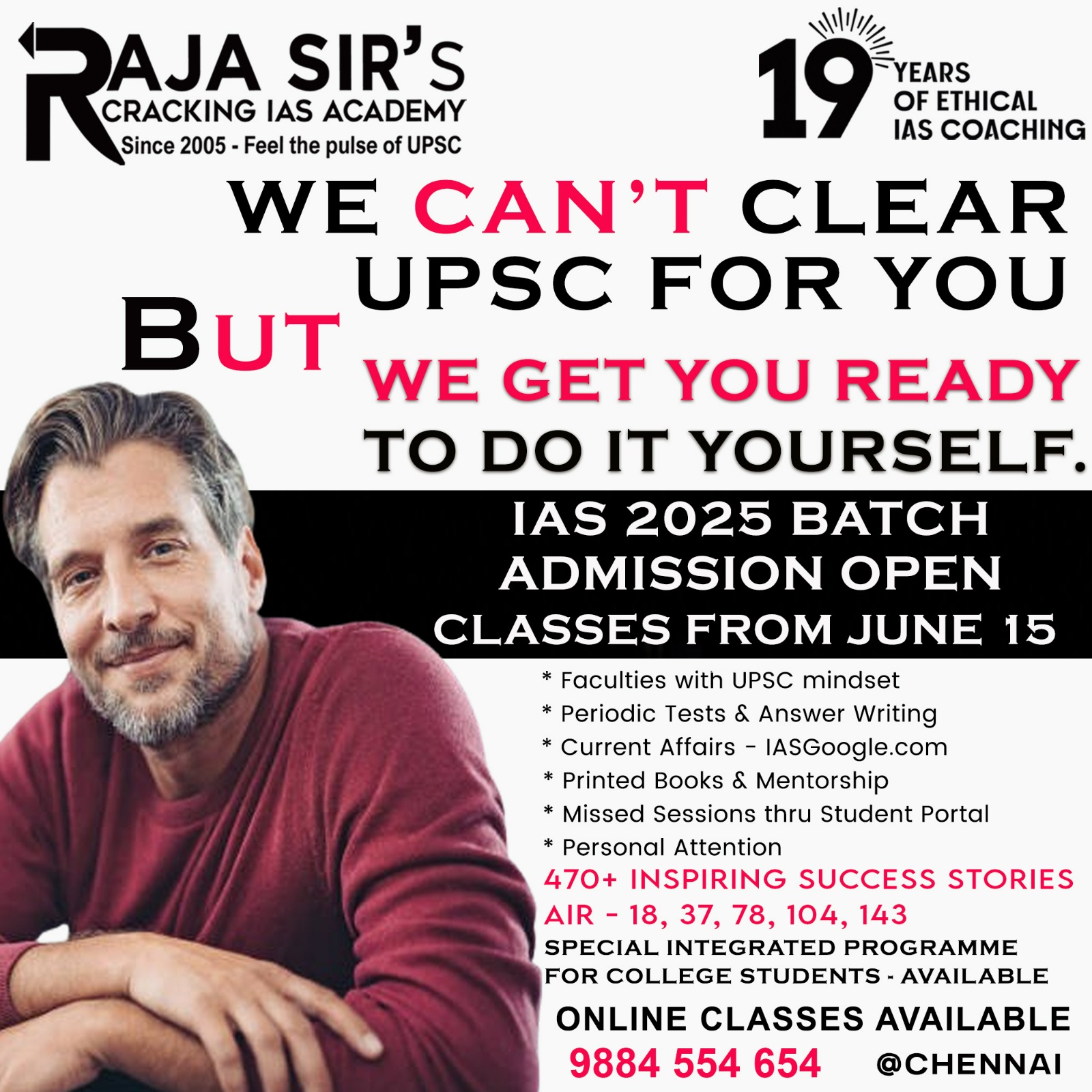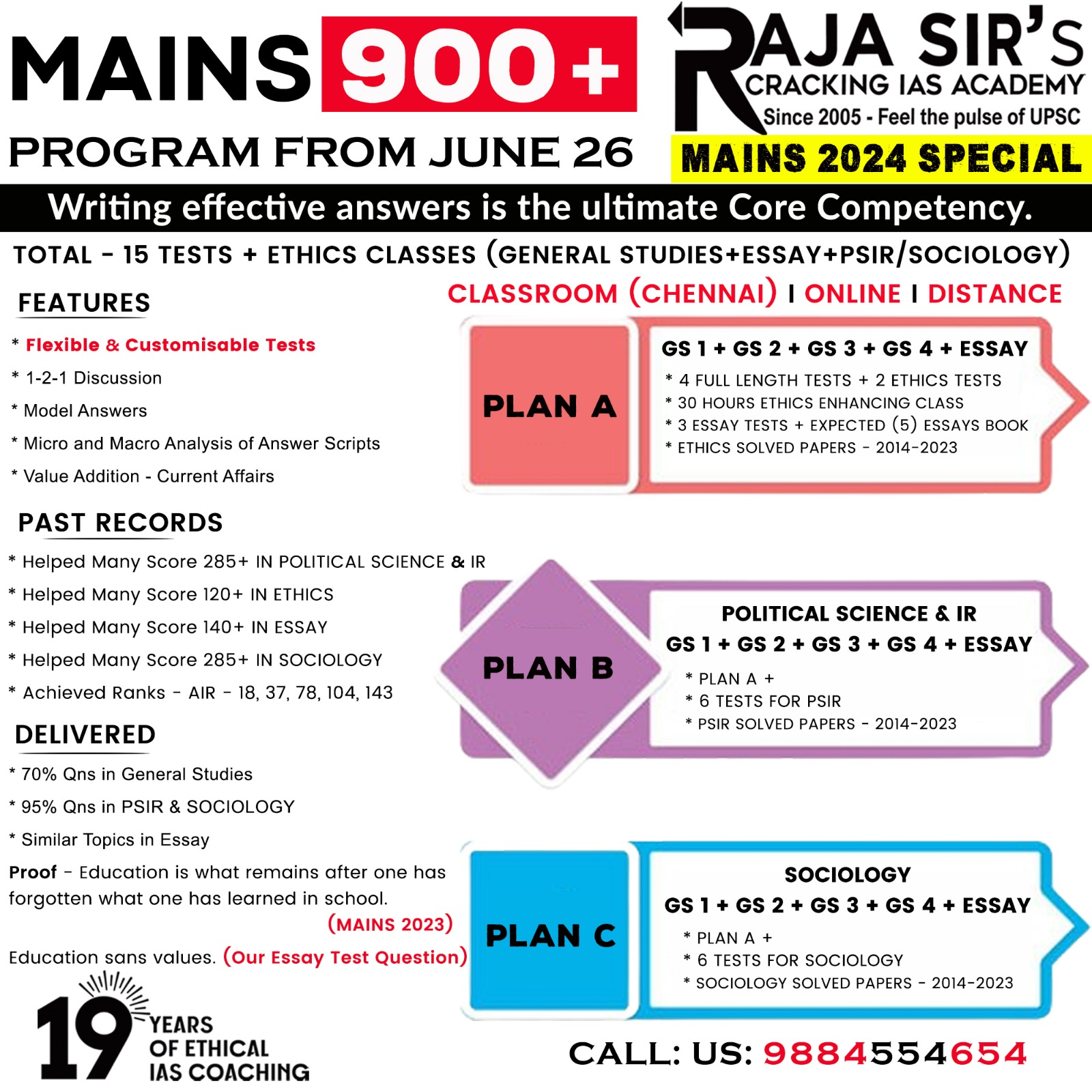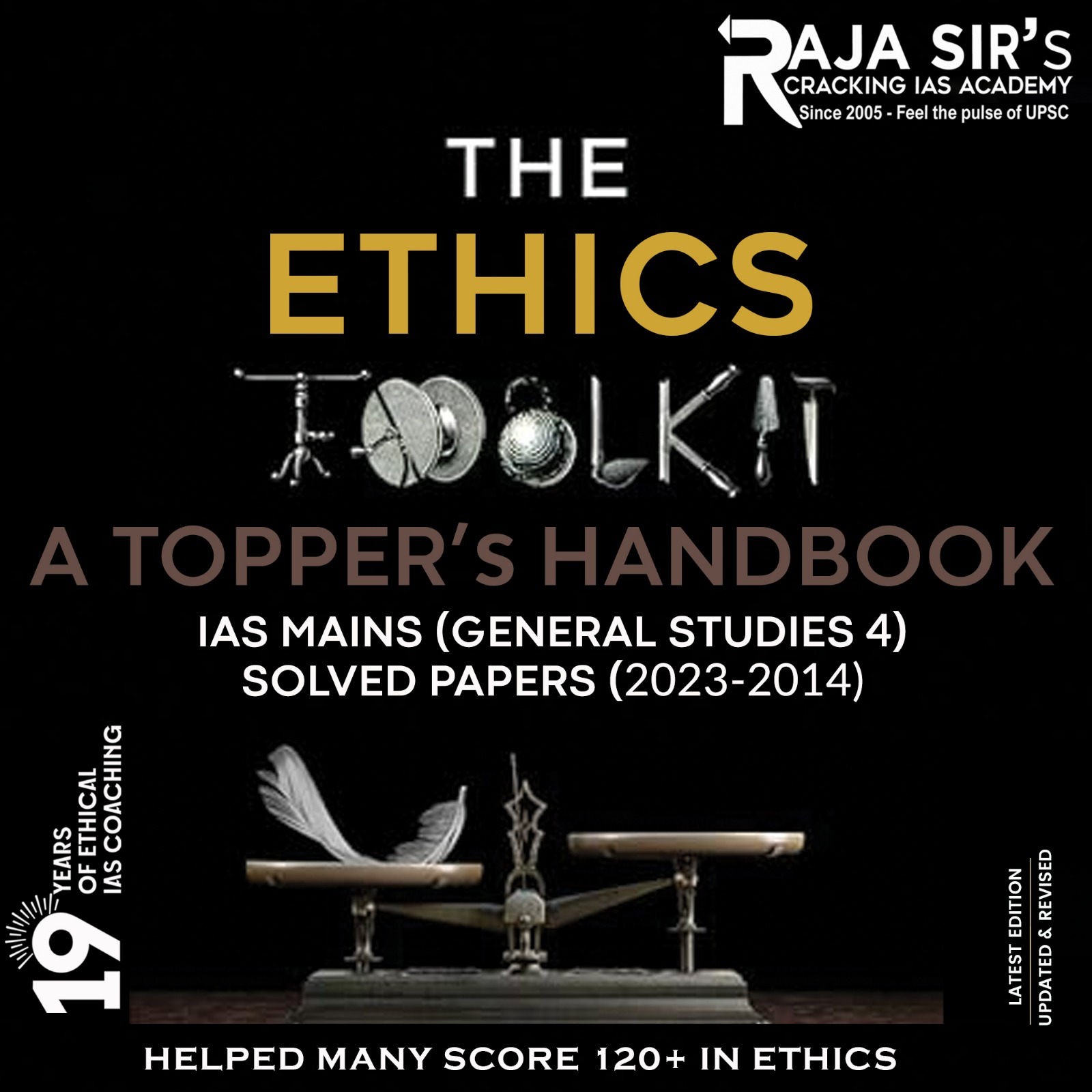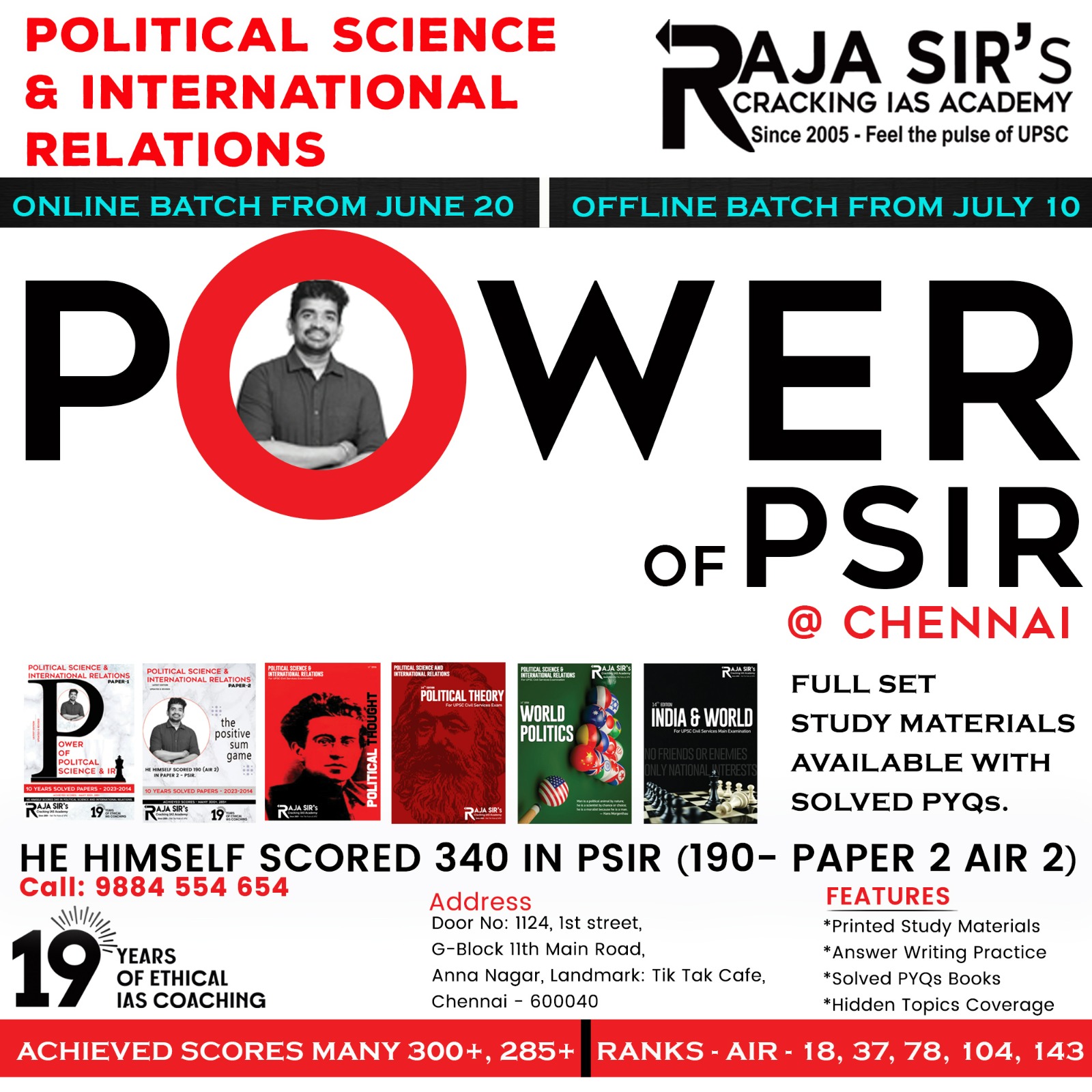- Home
- Prelims
- Mains
- Current Affairs
- Study Materials
- Test Series
 EDITORIALS & ARTICLES
EDITORIALS & ARTICLES
Hit List Questions 72-PPP 100 PRELIMS 2024 - 90
Questions & Explanations:
|
1. |
Match the following works with their authors:
(a) A-1, B-2, C-3. (b) A-1, B-3, C-2. (c) A-2, B-3, C-1. (d) A-2, B-1, C-3.
|
||||||||
|
2. |
1. It is a viral disease. 2. It is spread through pigs. Which of the statements given above is/are correct about Lyme disease? (a) 1 only (b) 2 only (c) Both 1 and 2 (d) Neither 1 nor 2 |
||||||||
|
3. |
Somalia is bordered by 1. Ethiopia 2. Djibouti 3. Kenya 4. Tanzania (a) 1 and 3 only (b) 1, 2 and 3 only (c) 1, 2, 3 and 4 (d) 1, 3 and 4
|
||||||||
|
4. |
1. There is a famous temple dedicated to him in Chennai. 2. His work thirukkural belongs to the 3rd Sangam period. Which of the statements given above is/are correct w.r.t. Thiruvalluvar? (a) 1 only (b) 2 only (c) Both 1 and 2 (d) Neither 1 nor 2
|
||||||||
|
5. |
Judgement in P.V Narasimha Rao v. State (1998) is related to (a) Horse Trading in Politics (b) Supremacy of Fundmaental Rights over Directive Principles (c) Parliamentary Immunity (d) Hawala Scam and SEBI
|
||||||||
|
6. |
‘Darien Gap’ seen in the news passes through 1. Columbia 2. Panama 3. Mexico 4. Venezuela Select the correct answer using the code given below: (a) 2, 3 and 4 only (b) 1, 2 and 4 only (c) 1 and 2 only (d) 1, 2, 3 and 4
|
||||||||
|
7. |
Consider the following: 1. Mahad Satyagraha movement 2. Founding of Bahishkrit Hitkarini Sabha 3. Founding of Adi-Dravida Mahajana Sabha 4. Yeola Conference Arrange this in correct chronological order. (a) 3,1,2,4 (b) 3,2,4,1 (c) 3,2,1,4 (d) 3,1,4,2
|
||||||||
|
8. |
‘D-8’ countries include 1. Bangladesh 2. Srilanka 3. Pakistan 4. Iran (a) 1, 3 and 4 only (b) 1, 2 and 3 only (c) 1 and 3 only (d) 1, 2, 3 and 4
|
||||||||
|
9. |
Folk Dance form State 1. Garba Mizoram 2. Giddha Punjab 3. Dhumal Assam Which of these is/are the correct pair (s)?. (a) 2 and 3 only (b) 1, 2 and 3 (c) 1 and 3 only (d) 1 only
|
||||||||
|
10. |
“Kokborok” in news refer to (a) Hills (b) Language (c) Breed of Buffalo (d) An endangered Himalayan Tree
|
||||||||
|
11. |
H5N1 infects 1. Sea Lions 2. Dolphins 3. Birds (a) 3 only (b) 2 and 3 only (c) 1 and 2 only (d) 1, 2 and 3
|
||||||||
|
12. |
Consider the following statements w.r.t. Bauxite. 1. It is an igneous rock. 2. It has high aluminium content. 3. It has gallium in trace amounts. Which of the statements given above is/are correct?. (a) 1 and 3 only (b) 1 and 2 only (c) 2 and 3 only (d) 1, 2 and 3
|
||||||||
|
13. |
Which of the following is/are true w.r.t. “Mahima Gosain”?. (a) He opposed caste system. (b) He was a montheist. (c) Both (a) and (b) (d) Neither (a) nor (b)
|
||||||||
|
14. |
Consider the following statements w.r.t. “Fast Breeder Reactor”. 1. It uses the Uranium-Plutonium Mixed Oxide fuel. 2. It breeds more fissile material than the fuel they consume. Which of the statements given above is/are correct?. (a) 1 only (b) 2 only (c) Both 1 and 2 (d) Neither 1 nor 2
|
||||||||
|
15. |
Which of the following is/are correct w.r.t. Andaman and Nicobar Islands?. 1. The islands share four of India’s international maritime zone delimitations with Myanmar, Thailand, Indonesia, and Bangladesh. 2. Sabang in Indonesia is 90 nautical miles southeast of Indira Point on Great Nicobar. 3. Kra Canal connects the Gulf of Thailand with the Andaman Sea. 4. The Andaman Sea lies to the east of Coco Islands of Myanmar. Select the correct answer from the code given below:- (a) 3 & 4 (b) 1, 3 & 4 (c) 1, 2, 3 & 4 (d) 1 & 4
|
||||||||
|
16. |
Consider the following statements w.r.t. Article 244(A) of Indian Constitution. 1. It was inserted by 24th Amendment Act. 2. It allows for the creation of an ''autonomous state'' within Assam in certain tribal areas. 3. It envisages creation of a local legislature or Council of Ministers or both to carry out local administration. 4. It accounts for more autonomous powers to tribal areas than the Sixth Schedule. Which of these is/are correct?. (a) 1, 2 and 3 only (b) 2 and 4 only (c) 3 and 4 only (d) 2, 3 and 4 only
|
||||||||
|
17. |
Which of the following is/are true about World Trade Organization? (a) General Agreement on Tariffs and Trade was its predecessor. (b) A trade liberalization framework was adopted in The Uruguay Round. (c) Both (a) & (b) are correct. (d) Neither (a) nor (b) is correct.
|
||||||||
|
18. |
Consider the following statements regarding ''Chaurapanchasika style of painting''. 1. Chaurapanchasika is a manuscript written by Kalidasa and all paintings are directly related to his narrations. 2. All the paintings are in oblong format with the text written on reverse. 3. Painting in a single plane with background in brilliant primary colours. Which of the above statement(s) is/are correct?. (a) 2 and 3 only (b) 1 and 3 only (c) 1 and 2 only (d) 1, 2 and 3
|
||||||||
|
19. |
Which of the following books of ancient India has play of the union of Udayana and daughter of the king Dridhavarman?. (a) Ratnavali (b) Priyadarshika (c) Urubhanga (d) Nagananda
|
||||||||
|
20. |
As a naturalist, he was interested in the study of plants and his court artists in their floral portraiture describe some fifty-seven plants. Who is referreed here?. (a) Akbar (b) Humayun (c) Jahangir (d) Aurangazeb
|
||||||||
|
21. |
W.r.t. ‘The Bhojeshwar Mahadev Temple’, consider the following: 1) Raja Bhoj a ruler of the Paramara dynasty constructed it. 2) It is built in the Bhumija style. Which of the statements given above is/are correct?. (a) 1 only (b) 2 only (c) Both 1 and 2 (d) Neither 1 nor 2
|
||||||||
|
22. |
Arrow system missiles seen in news frequently belong to (a) Israel (b) Ukraine (c) Iran (d) France
|
||||||||
|
23. |
W.r.t. ‘Guru Ravidas’, consider the following: 1) He was a Dalit and a contemporary of Kabir. 2) His 41 hymns have been included in the Guru Granth Sahib. Which of the statements given above is/are correct?. (a) 1 only (b) 2 only (c) Both 1 and 2 (d) Neither 1 nor 2
|
||||||||
|
24. |
Consider the following Bhakti Saints: 1. Dadu Dayal 2. Guru Nanak 3. Tyagaraja Who among the above was/were preaching when the Lodi dynasty fell and Babur took over? (a) 1 and 3 (b) 2 only (c) 2 and 3 (d) 1 and 2
|
||||||||
|
25. |
What is/are true w.r.t. liquid nitrogen? 1. It is used in artificial insemination. 2. It is used to remove unwanted skin, warts and pre-cancerous cells. 3. It delays foods from turning rancid. (a) 1 and 3 only (b) 1, 2 and 3 (c) 1 and 2 only (d) 1 only |
EXPLANATIONS
|
1. |
https://nios.ac.in/media/documents/SecICHCour/English/CH.15.pdf |
C |
|||||||||||||||||||||||||||||||||||||||||||||||||||||||||||||||||||||||||||||||||||||||||||||||||||||||||||||||||||||||||||||||||||||||||||||||||
|
2. |
D |
||||||||||||||||||||||||||||||||||||||||||||||||||||||||||||||||||||||||||||||||||||||||||||||||||||||||||||||||||||||||||||||||||||||||||||||||||
|
3. |
B |
||||||||||||||||||||||||||||||||||||||||||||||||||||||||||||||||||||||||||||||||||||||||||||||||||||||||||||||||||||||||||||||||||||||||||||||||||
|
4. |
There is a famous temple dedicated to him in Virudhunagar district. The Sangam Age is a significant phase in the history of ancient South India, spanning roughly from the 3rd century BCE to the 3rd century CE. It is also referred to as the period of Tamil Literature. The term "Sangam" refers to assemblies or gatherings of poets and scholars that took place in ancient South India. These gatherings were instrumental in nurturing a literary tradition that focused on various aspects of life, including love, war, ethics, politics, and nature. The works composed by different poets during the Sangam age provide insights into the social, cultural, and political dynamics of the time. The Sangam age left a significant cultural legacy, influencing the region''s history and heritage. Sangam Literature According to Tamil scholars, three sangams (academies of Tamil poets) existed in ancient Tamil Nadu, also known as Muchchangam. Under the Pandyan dynasty''s royal patronage, these Sangam flourished. These Tamil literary works continue to be valuable resources for rewriting Sangam age history.
Early Sangam Literature The earliest Sangam literature provides invaluable insights into the social, cultural, and literary aspects of ancient South India. It incudes Agattiyam, Tolkappiyam, Ettuttogai and Pattuppattu. Aham and Puram Concept The use of the poetic form is an important aspect of Sangam literature. Tholkappiyam, an ancient Tamil treatise, divides poetry into two categories: Aham and Puram. These two are related in the sense that they are the polar opposites of each other while also complementing each other.
Agattiyam (Akattiyam) Agattiyam was the earliest book on Tamil grammar according to Tamil tradition.
Tolkappiyam It was written by Tolkappiyar and is considered the first Tamil literary work.
Ettuttogai Ettuttogai is a classical Tamil poetic work consisting of eight works long and short, both or eight anthologies. It is included in the Pathinen Melkanakku (Eighteen Greater Texts).
Pattuppattu It is an anthology of ten longer poems in the Sangam literature – the earliest known Tamil literature.
Later Sangam Literature The Sangam age was a time of great literary achievement, where poets and scholars thrived, creating a vibrant literary tradition.
Patinen Kilkanakku (The Eighteen Lesser Texts) It is a collection of eighteen poetic works created during the post-Sangam period. It mainly deals with morals and ethics.
Five Great Epics
Other Literary Sources of the Sangam Age
Art and Architecture During Sangam Age Art and architecture during the Sangam Age in ancient South India were not as extensively documented as the literature. While physical remnants are rare, references in literature and archaeological findings provide insights into the art and architecture during the Sangam age. Art of Sangam Age
Architecture of Sangam Age Information and documentation regarding the architecture of the Sangam ages are limited. It can, however, be deduced from literary references.
Keeladi Excavation
|
B |
|||||||||||||||||||||||||||||||||||||||||||||||||||||||||||||||||||||||||||||||||||||||||||||||||||||||||||||||||||||||||||||||||||||||||||||||||
|
5. |
C |
||||||||||||||||||||||||||||||||||||||||||||||||||||||||||||||||||||||||||||||||||||||||||||||||||||||||||||||||||||||||||||||||||||||||||||||||||
|
6. |
C |
||||||||||||||||||||||||||||||||||||||||||||||||||||||||||||||||||||||||||||||||||||||||||||||||||||||||||||||||||||||||||||||||||||||||||||||||||
|
7. |
Mahad Satyagraha, December 1927. Ambedkar at the time was helping Dalits fight against the social evil of untouchability through the Bahishkrit Hitkarini Sabha, the institution that he had founded in 1924. In the Yeola Conference in 1935, Ambedkar thundered “I was born as a Hindu, I solemnly assure you that I will not die as a Hindu”. Rettamalai Srinivasan said, “Depressed Classes are not in the Hindu fold. They are full blooded Dravidian in race”. Rettamalai Srinivasan established and led the Paraiyar Mahajana Sabha in 1891 which later became Adi-Dravida Mahajana Sabha in 1893. https://pib.gov.in/PressReleasePage.aspx?PRID=1916229 https://indianexpress.com/article/opinion/columns/ambedkar-and-political-reservation-6557591/ |
C |
|||||||||||||||||||||||||||||||||||||||||||||||||||||||||||||||||||||||||||||||||||||||||||||||||||||||||||||||||||||||||||||||||||||||||||||||||
|
8. |
Bangladesh, Egypt, Indonesia, Iran, Malaysia, Nigeria, Pakistan and Turkey. Developing Eight (D-8) was established through the Istanbul Declaration, which was agreed at the 1st D-8 Summit on June 15, 1997 in Istanbul, Turkiye. D-8 consists of eight developing countries, namely Bangladesh, Egypt, Indonesia, Iran, Malaysia, Nigeria, Pakistan and Turkiye.
|
A |
|||||||||||||||||||||||||||||||||||||||||||||||||||||||||||||||||||||||||||||||||||||||||||||||||||||||||||||||||||||||||||||||||||||||||||||||||
|
9. |
D- 2 ONLY https://nios.ac.in/media/documents/SecICHCour/English/CH.12.pdf |
D |
|||||||||||||||||||||||||||||||||||||||||||||||||||||||||||||||||||||||||||||||||||||||||||||||||||||||||||||||||||||||||||||||||||||||||||||||||
|
10. |
B |
||||||||||||||||||||||||||||||||||||||||||||||||||||||||||||||||||||||||||||||||||||||||||||||||||||||||||||||||||||||||||||||||||||||||||||||||||
|
11. |
https://indianexpress.com/article/explained/explained-global/h5n1-bird-flu-mammals-9236846/ |
D |
|||||||||||||||||||||||||||||||||||||||||||||||||||||||||||||||||||||||||||||||||||||||||||||||||||||||||||||||||||||||||||||||||||||||||||||||||
|
12. |
Bauxite is an aluminum-rich sedimentary rock. |
C |
|||||||||||||||||||||||||||||||||||||||||||||||||||||||||||||||||||||||||||||||||||||||||||||||||||||||||||||||||||||||||||||||||||||||||||||||||
|
13. |
https://pib.gov.in/PressReleaseIframePage.aspx?PRID=1979765 Bhima Bhoi Early Life
Spiritual Journey and Teachings
Literary Works
Impact and Legacy
Mahima Cult:
Founder and Key Figures
Core Beliefs and Doctrines
Ethical Codes and Practices
Social Impact
|
C |
|||||||||||||||||||||||||||||||||||||||||||||||||||||||||||||||||||||||||||||||||||||||||||||||||||||||||||||||||||||||||||||||||||||||||||||||||
|
14. |
C |
||||||||||||||||||||||||||||||||||||||||||||||||||||||||||||||||||||||||||||||||||||||||||||||||||||||||||||||||||||||||||||||||||||||||||||||||||
|
15. |
· The Coco Islands are a small group of islands in the northeastern Bay of Bengal. · They are part of the Yangon Region of Myanmar. · Coco Island group consists of five islands: four on Great Coco Reef and one on the Little Coco Reef. · To the north of this island group lies Preparis Island, belonging to Myanmar. · To the south lies the Landfall Island, belonging to India. · The Bay of Bengal lies to the west of the islands. The Andaman Sea lies to the east. · The Coco Islands consist of three main islands, namely Great Coco Island and the smaller Little Coco Island, separated by the Alexandra Channel, as well as Table Island, a third small island located near Great Coco Island. · Geographically, they are a part of the Andaman and Nicobar Islands archipelago, most of which belongs to India. They are separated from Landfall Island, the northernmost island in the Indian part of the archipelago, by the 20 kilometres wide Coco Channel. |
C |
|||||||||||||||||||||||||||||||||||||||||||||||||||||||||||||||||||||||||||||||||||||||||||||||||||||||||||||||||||||||||||||||||||||||||||||||||
|
16. |
It was inserted by 22nd Amendment Act, 1969. https://indianexpress.com/article/explained/article-244a-diphu-assam-9288844/ |
A |
|||||||||||||||||||||||||||||||||||||||||||||||||||||||||||||||||||||||||||||||||||||||||||||||||||||||||||||||||||||||||||||||||||||||||||||||||
|
17. |
Major outcomes of MC13 ● Abu Dhabi Ministerial Declaration: It adopts a Ministerial Declaration setting out a forward-looking, reform agenda for the organization. It is committed to preserve and strengthen the ability of the multilateral trading system, with the WTO at its core, to respond to current trade challenges. ● WTO membership for Comoros and Timor-Leste: Ministers formally approved the WTO membership terms of Comoros, an island LDC in Africa and Timor-Leste, an island LDC in Asia at MC 13. Comoros and Timor-Leste will bring the total number of WTO members to 166. ● On dispute settlement reform: Renewing the commitment to have a fully and well-functioning dispute settlement system by 2024. ○ Ministers instructed officials to accelerate discussions, build on the progress already made, and work on unresolved issues. ● Special and differential treatment (S&DT): To improve use of the special and differential treatment (S&DT) provisions for developing and least developed countries (LDCs) with a view to making them more precise, effective and operational. |
C |
|||||||||||||||||||||||||||||||||||||||||||||||||||||||||||||||||||||||||||||||||||||||||||||||||||||||||||||||||||||||||||||||||||||||||||||||||
|
18. |
Chaurapanchasika is a set of 50 verses written by a Kashmiri Pandit Bilhana in the 11th century. The Chaurapanchasika group tries to present the pictures in an expressive way by introducing certain attitudes, figures and background to convey the sense of the verse through gesture, symbol or mood. These miniatures are to be read as books. Each picture is in complete itself as a verse and is an integral part of Indian paintings. |
A |
|||||||||||||||||||||||||||||||||||||||||||||||||||||||||||||||||||||||||||||||||||||||||||||||||||||||||||||||||||||||||||||||||||||||||||||||||
|
19. |
• ‘Priyadarsika’ is a sanskrit play written by Harshavardhana, The play tells the union of Udayana and Priyadarshika, daughter of king Dridhavarman. • Harshavardhana was an Indian sovereign who referred to Pushibhukti family. He was born nearby 580 AD and is considered to be the heir of Prabhakar Vardhan, the patron of Vardhan Dynasty. · He was a good intellectual and celebrated writer. He wrote three plays in Sanskrit namely Ratnavali, Priyadarsika and Nagananda. We can obtain a well-documented account of his reign in the work of his court author Banabhatta. Bana reproduced Harsha Charita, the first traditional dramatic work in the Sanskrit language. |
B |
|||||||||||||||||||||||||||||||||||||||||||||||||||||||||||||||||||||||||||||||||||||||||||||||||||||||||||||||||||||||||||||||||||||||||||||||||
|
20. |
· https://nios.ac.in/media/documents/SecICHCour/English/CH.14.pdf |
C |
|||||||||||||||||||||||||||||||||||||||||||||||||||||||||||||||||||||||||||||||||||||||||||||||||||||||||||||||||||||||||||||||||||||||||||||||||
|
21. |
Architectural features of the temple: · Architectural style reflects the evolution of temple design during the Paramara period. · Elements of the Bhumija style emerged in the 9th century and flourished until the 13th century. · Bhumija style is an evolved form of the Nagara temples. · The main structure and the shikhara in this style harmoniously blend influences from the Dravidian style of temple architecture. · The temple does not have a mandapa, which have led researchers to propose the hypothesis of it being a funerary monument. · The unfinished shikhara is decorated with small sub-shrines or kuta-stambhas and corner bands known as Lata. · The temple has a square plan and it is built on a raised plinth with ornate carvings and sculptures in its exterior. · In the centre, the garbhagriha is constructed which houses a massive lingam, carved from a single stone. · Projecting balconies are built on three sides of the temple. · The northern wall features a makara-pranala, which provided a drainage outlet for the liquid used to bathe the lingam. · The four brackets supporting the cornerstones feature four different divine couples: Shiva-Parvati, Brahma-Shakti, Rama-Sita, and Vishnu-Lakshmi. Paramara Dynasty (9th-14th Century): Introduction: · Exerted dominion over Malwa and adjacent territories in west-central India. · Originated from the Parmara clan of Rajputs. · Initially served as vassals to the Rashtrakutas of Manyakheta. · They rose to sovereign power around 972 CE when Siyaka, one of the rulers, sacked Manyakheta and established Paramaras as an independent authority. · Capital: Dhara (modern-day Dhar) · The dynasty faced repeated conflicts with neighbouring kingdoms such as the Chaulukyas of Gujarat, the Chalukyas of Kalyani, the Kalachuris of Tripuri, and the Chandelas of Jejakabhukti. · Due to the challenges, the capital was shifted to Mandapa-Durga (now Mandu). · Religion: · Predominantly followers of the Shaivite tradition. · Also supported Jain scholars Rulers: · Earliest known king Siyaka: · Harsola copper plate inscription (949 CE), mentions him as vassal to the Rashtrakuta ruler Krishna III. · As a Rashtrakuta vassal, Siyaka engaged in military campaigns against the Pratiharas and Hunas. · He secured victory over Krishna III’s successor, Khottiga, in 972 CE. · Munja (Siyaka’s successor): · Munja attained victory over various neighbouring kingdoms, such as Chahamanas, Guhilas, Hunas, and Kalachuris. · He was defeated by Western Chalukya king Tailapa II. This resulted in loss of southern territories to the Chalukyas. · Sindhuraja (Munja’s successor): · He reclaimed the lost territories by defeating the Western Chalukya king Satyashraya. · He expanded the dominion by defeating Shilaharas, Somvanshi, and rulers of Lata (now South Gujarat). · His court poet, Padma Gupta, wrote his biography, Nava-Sahasanka- Charita. · King Bhoja (Sindhuraja’s son and successor): · Reigned from 1010–1055 CE. · The dynasty reached its zenith during his reign. · Bhoja’s inscriptions mention his titles as Parama Bhattaraka, Maharajadhiraja and Parameshvara. · Extended control from Chittor in the north to upper Konkan in the south, and from the Sabarmati River in the west to Vidisha in the east. · He founded the town of Bhojpur. Cultural Contributions of King Bhoja: · Under his rule, Malwa and its capital Dhara became one of the chief intellectual centres of India. · Chintamani-Sarnika (1055 CE) was composed by his court poet Dasabala. · Besides the Bhojeshwar Temple, he also construction of three dams in Bhojpur. · The first dam, built on Betwa River. · A second dam was constructed in a gap between the hills. · A third dam diverted more water from the smaller Kaliasot river. · Bhoja established the Bhoj Shala which was a centre for Sanskrit studies and a temple of Saraswati in Dhar. · Bhoja was renowned as a scholar king, and several books are attributed to him. He was an expert on poetry, and the treatise Shringara-Prakasha was authored by him. · Some of his surviving works in Sanskrit language: · Bhujabala-bhima, a work on astrology · Champu-Ramayana or Bhoja-Champu, a re-telling of the Ramayana in mixture of prose and poetry (champu genre) · Govinda-vilasa, poem · Raja-Martaṅda or Patanjali Yogasutra Bhashya, a major commentary on the Yoga Sutras of Patanjali · Raja Mriganka Karana, a treatise on chemistry, dealing with the extraction of metals from ores, and production of various drugs. · Samarangana-Sutradhara, a treatise on architecture and iconography. · Sarasvati-Kanthabharana, a treatise on Sanskrit grammar for poetic and rhetorical compositions. · Tattva-Prakasha, a treatise on Shaivite philosophy. · Vidvajjana-Vallabha, treatise on astronomy. · Vyavahara-Manjari, a work on dharmasastra or Hindu law · Yukti-Kalpataru, a work dealing with several topics including statecraft, politics, city-building etc. · His Prakrit language poems are: Kodanda-Kavya and Kurma-Sataka. · The Kodanda-Kavya was found inscribed on stone slab fragments at Mandu. · The Kurma-Sataka was found inscribed at the BhojShala in Dhar. The Paramara Dynasty experienced a decline in their power, ultimately leading to the defeat and death of the final recorded ruler, Mahalakadeva, by the forces of Alauddin Khilji of Delhi in 1305 CE. However, despite this, inscriptions indicate that Paramara authority persisted for some time following Mahalakadeva’s downfall. |
C |
|||||||||||||||||||||||||||||||||||||||||||||||||||||||||||||||||||||||||||||||||||||||||||||||||||||||||||||||||||||||||||||||||||||||||||||||||
|
22. |
A |
||||||||||||||||||||||||||||||||||||||||||||||||||||||||||||||||||||||||||||||||||||||||||||||||||||||||||||||||||||||||||||||||||||||||||||||||||
|
23. |
https://www.thehindu.com/society/faith/guru-ravidas-seer-social-reformer/article67884907.ece |
C |
|||||||||||||||||||||||||||||||||||||||||||||||||||||||||||||||||||||||||||||||||||||||||||||||||||||||||||||||||||||||||||||||||||||||||||||||||
|
24. |
Guru Nanak ( 1469 – 1539) Dadu Dayal (1544–1603) Kakarla Tyagabrahmam (1767 – 1847) Lodi dynasty fell and Babur took over: 1526. Guru Nanak ( 1469 – 1539) Dadu Dayal (1544–1603) Kakarla Tyagabrahmam (1767 – 1847) Lodi dynasty fell and Babur took over: 1526
|
B |
|||||||||||||||||||||||||||||||||||||||||||||||||||||||||||||||||||||||||||||||||||||||||||||||||||||||||||||||||||||||||||||||||||||||||||||||||
|
25. |
https://www.ferrovial.com/en/stem/liquid-nitrogen/ Liquid nitrogen, which has a boiling point of -196C, is used for a variety of things, such as a coolant for computers, in medicine to remove unwanted skin, warts and pre-cancerous cells, and in cryogenics, where scientists study the effect of very cold temperatures on materials. It has also become increasingly common at top restaurants as a method for instantly freezing food and drinks, or creating an impressive cloud of vapour or fog when exposed to air. |
B |









 Latest News
Latest News




 General Studies
General Studies